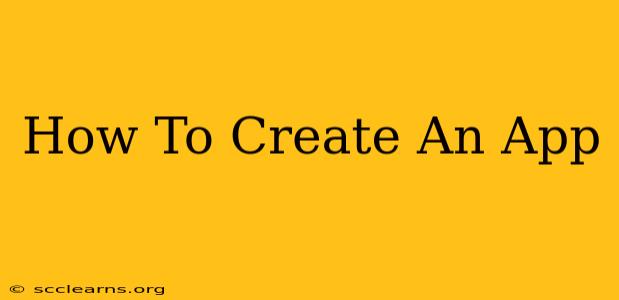So, you've got a great app idea brewing? Fantastic! Turning that idea into a reality might seem daunting, but with the right approach and resources, you can build your dream app. This comprehensive guide will walk you through the entire process, from initial concept to launch and beyond.
1. Ideation and Planning: Laying the Foundation
Before diving into code, meticulous planning is crucial. This phase sets the stage for a successful app.
a) Defining Your App's Purpose and Target Audience:
What problem does your app solve? Who is your ideal user? Understanding these fundamentals is critical. Consider:
- User Needs: What specific pain points will your app address?
- Target Demographics: Age, location, interests, tech-savviness of your users.
- Value Proposition: What makes your app unique and better than existing alternatives?
Strong market research is paramount here. Analyze competing apps, identify gaps, and refine your concept to stand out.
b) Features and Functionality:
List all the features your app will offer. Prioritize them based on importance and feasibility. Start with a Minimum Viable Product (MVP) – a basic version with core functionalities – to test the market and gather feedback before adding more complex features.
c) Choosing a Monetization Strategy:
How will you generate revenue? Options include:
- Freemium Model: Offer a basic free version with optional in-app purchases.
- Subscription Model: Charge users a recurring fee for access to features or content.
- In-App Advertising: Display ads within the app.
- One-Time Purchase: Charge a fixed price for the app.
2. Design and Development: Bringing Your App to Life
This is where your app takes shape.
a) UI/UX Design:
User interface (UI) and user experience (UX) design are vital for app success. A well-designed app is intuitive, user-friendly, and visually appealing. Consider:
- User Flows: How users navigate through your app.
- Wireframing: Creating basic sketches of app screens.
- Prototyping: Building interactive mockups to test usability.
Invest time in creating a seamless and enjoyable user experience.
b) Choosing a Development Platform:
Decide whether to build a native app (using platform-specific languages like Swift/Kotlin), a hybrid app (using frameworks like React Native or Flutter), or a cross-platform app. The choice depends on factors like budget, technical expertise, and desired performance.
c) Coding and Testing:
This is where the actual development happens. Thorough testing at every stage is essential to identify and fix bugs. Consider employing:
- Unit testing: Testing individual components of your app.
- Integration testing: Testing how different components work together.
- User acceptance testing (UAT): Testing with real users to gather feedback.
3. Launch and Marketing: Getting Your App into the World
Your hard work isn't over once the app is built. Effective marketing is crucial for success.
a) App Store Optimization (ASO):
ASO involves optimizing your app's listing in app stores to improve visibility and attract more downloads. This includes:
- Keyword Research: Identify relevant keywords to include in your app's title, description, and metadata.
- Compelling Screenshots and Videos: Showcase your app's best features.
- High-Quality App Icon: Make a strong visual impression.
b) Marketing and Promotion:
Promote your app through various channels:
- Social Media Marketing: Engage with potential users on platforms like Facebook, Instagram, and Twitter.
- Content Marketing: Create blog posts, articles, and videos about your app.
- App Store Advertising: Run paid advertising campaigns to reach a wider audience.
- Public Relations: Reach out to tech bloggers and journalists to get coverage.
c) Post-Launch Monitoring and Updates:
Continuously monitor user reviews, feedback, and app performance. Release regular updates to improve functionality, address bugs, and add new features.
Conclusion: The Journey of App Creation
Creating a successful app requires dedication, planning, and ongoing effort. By following these steps, you can significantly increase your chances of bringing your app idea to life and achieving your goals. Remember to adapt and iterate based on user feedback and market trends. Good luck!

